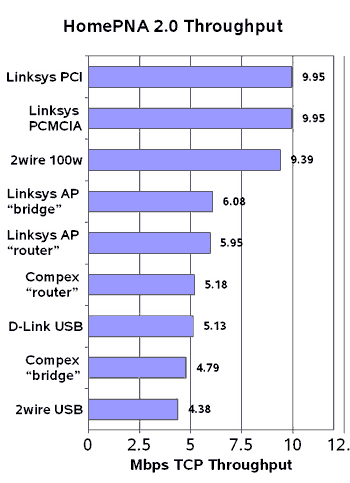Digging into Phoneline Networking and HomePNA 2.0
by Eric Hagen on December 20, 2001 12:00 PM EST- Posted in
- IT Computing
Network Throughput
Before we get into the chart, lets clear up some of the terminology used on it. “Bridge” mode indicates that we tested the interface independent of the internal router. This was accomplished by enabling “bridge” mode on the Compex TH102A and by testing the Linksys HPRO200 only on the LAN side. Those labeled “router” tested the connection speed through the router with NAT enabled, using port forwarding to pass the packets to the second host. Also of note, the 2wire 100w is only listed once because it (remarkably) scored EXACTLY the same score from both the LAN and WAN.

As you can see, there are clearly two tiers of performance. The reason for this is unclear, however; as we pointed out, engineers from Compex confirmed that their core logic only supported the 2Mbaud specification of HomePNA 2.0. That means theoretically they should only be half the speed. However, we didn’t expect them to show such a wide disparity in testing.
While it is worthwhile to point out that every environment is different, we did our best to simulate a real home environment, connecting the devices to different phone jacks in a home with 6 phones. The phone lines were also carrying an aDSL signal and even testing during a voice conversation did not yield a noticeable speed loss (well under 5% and probably negligible).
It should be noted that every phone attached to our network was equipped with a DSL phone filter, which clips all frequencies above a certain frequency and therefore, would have removed much of the outside interference from the network. However, since all homes with DSL should have these filters installed, this shouldn't invalidate the tests.
We will be contacting engineers from several of the other manufacturers to try to verify these conclusions.










0 Comments
View All Comments